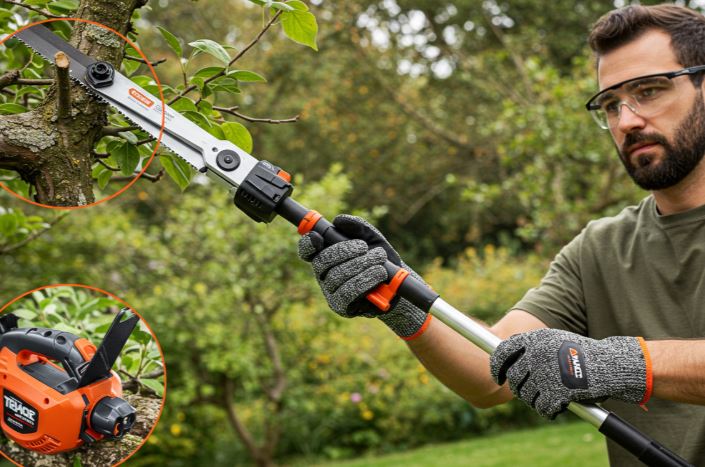If you’re using a pole saw for overhead cutting, you’ve probably encountered that unsettling moment when the saw kicks back unexpectedly—like when a branch you thought was dead surprises you with its sturdiness. After helping countless clients navigate the complexities of safe pole saw usage, here’s what actually works to keep you safe and effective.
The Importance of Safety Gear
Before you even think about reaching for your pole saw, let’s talk about the essential safety gear. Wearing the right equipment can mean the difference between a successful pruning session and a trip to the emergency room.
Eye Protection
Your eyes are invaluable, and nothing ruins a day outdoors like a flying wood chip. Invest in high-quality safety glasses with side shields. They should fit snugly to prevent any debris from sneaking in. Remember, even a small shard can cause serious damage.
Head Protection
A hard hat is not just for construction sites. When you’re working overhead, the risk of falling branches or tools increases significantly. Choose a hard hat that’s lightweight yet durable. Consider those with built-in visors for added eye protection.
Hearing Protection
Don’t underestimate the impact of noise. Pole saws can produce sound levels that are harmful over time. Use earplugs or earmuffs to protect your hearing, especially during prolonged use. A good rule of thumb: if you have to shout for someone to hear you, you need hearing protection.
Gloves and Footwear
Wear cut resistant gloves to protect your hands from sharp edges and splinters. As for footwear, sturdy, non-slip boots with reinforced toes can prevent injuries from falling objects or slips on uneven ground.
Preparing for the Job
Preparation is key when it comes to using a pole saw effectively. Here’s how to set yourself up for success.
Inspect Your Equipment
Before you start cutting, take a moment to inspect your pole saw. Are the blades sharp? Is the chain properly tensioned? A dull blade can lead to accidents as it requires more force to cut, which increases the risk of losing control. Here’s exactly how to check:
- Ensure the blade is clean and free of debris.
- Check that the chain tension is appropriate; it should not sag or be overly tight.
- Lubricate the chain as per the manufacturer’s instructions.
Assess Your Work Environment
Look around your work area. Are there power lines nearby? What about unstable footing or overhead obstructions? Walk the area and remove any potential hazards. This is a step many overlook, but an ounce of prevention here is worth a pound of cure.
Mastering Overhead Cutting Techniques
Now that you’re geared up and your tools are prepped, it’s time to master the techniques that will keep you safe while cutting overhead.
Stance and Grip
Your stance affects your stability. Stand with your feet shoulder-width apart, and keep your knees slightly bent. This lowers your center of gravity and helps maintain balance as you reach overhead. Grip the pole saw firmly with both hands, ensuring that your dominant hand is near the trigger and your non-dominant hand is at the base. This will give you maximum control.
Cutting Techniques
When it comes to cutting, always remember the three-cut method:
- Undercut: Make a small cut on the underside of the branch to prevent it from tearing as it falls.
- Top Cut: After the undercut, make a clean cut from the top to sever the branch completely.
- Final Cut: Remove any remaining stubs by cutting at a slight angle to promote healing.
This technique not only ensures a clean cut but also minimizes the risk of injury from falling debris.
Recognizing and Avoiding Hazards
Even seasoned professionals can encounter unexpected hazards. Here’s what to watch for while using a pole saw.
Watch for Kickback
Kickback occurs when the chain at the tip of the saw comes in contact with an object, causing the saw to jerk back toward you. This is a leading cause of injuries. To avoid kickback:
- Maintain a firm grip and keep both hands on the saw.
- Avoid cutting with the tip of the blade.
- Make sure you’re not cutting into any branch that is under tension, as it can snap back.
Be Aware of Falling Debris
Always anticipate where the branch will fall. Make sure no one is in the drop zone and that you’re standing clear of the area. Consider using a ground person to help direct the cut if you’re dealing with large or heavy branches.
Post-Cutting Procedures
Once you’ve completed your overhead cutting, it’s crucial to follow proper procedures to ensure safety and efficiency.
Clean Up Safely
After cutting, don’t just walk away. Take the time to remove debris from your work area. This includes branches, leaves, and any other materials that could pose a tripping hazard. Use a rake or broom to gather smaller debris and ensure that larger branches are neatly stacked away from pathways.
Inspect Your Equipment Again
After a day of work, double-check your pole saw. Clean the blade of sap and debris, lubricate moving parts, and store it in a dry place. This helps extend the life of your equipment and prepares you for your next job.
Conclusion: Embrace Safety and Efficiency
Using a pole saw for overhead cutting can be a rewarding experience when done safely. By equipping yourself with the right gear, preparing your environment, mastering cutting techniques, and being aware of potential hazards, you’ll not only protect yourself but also enhance your efficiency and enjoyment. Remember, safety should always be your top priority—never rush a job or take shortcuts. With the right approach, you can tackle even the tallest trees with confidence.
Read Next:



